A Conversation on Early Childhood Development with Museum Exhibit Doll
VerifiedAdded on 2023/06/13
|12
|3148
|493
Creative Assignment
AI Summary
This creative assignment presents an imaginary conversation between a student and an Armand Marseille baby doll museum exhibit, exploring various aspects of early childhood development. The discussion covers the loss of childhood innocence, changes in childhood practices across cultures, the role of children in their own development, shifts in play activities over time, the impact of single parenthood, and concerns about childhood obesity. The conversation highlights differences between early 20th-century childhood and modern experiences, addressing issues like increased stress, reduced playtime, premature maturity, and evolving language use among children. The student seeks the doll's perspective on these changes, particularly regarding play and games, prompting a reflection on how childhood has transformed over the decades. Desklib provides this assignment as a resource for students studying childhood development.
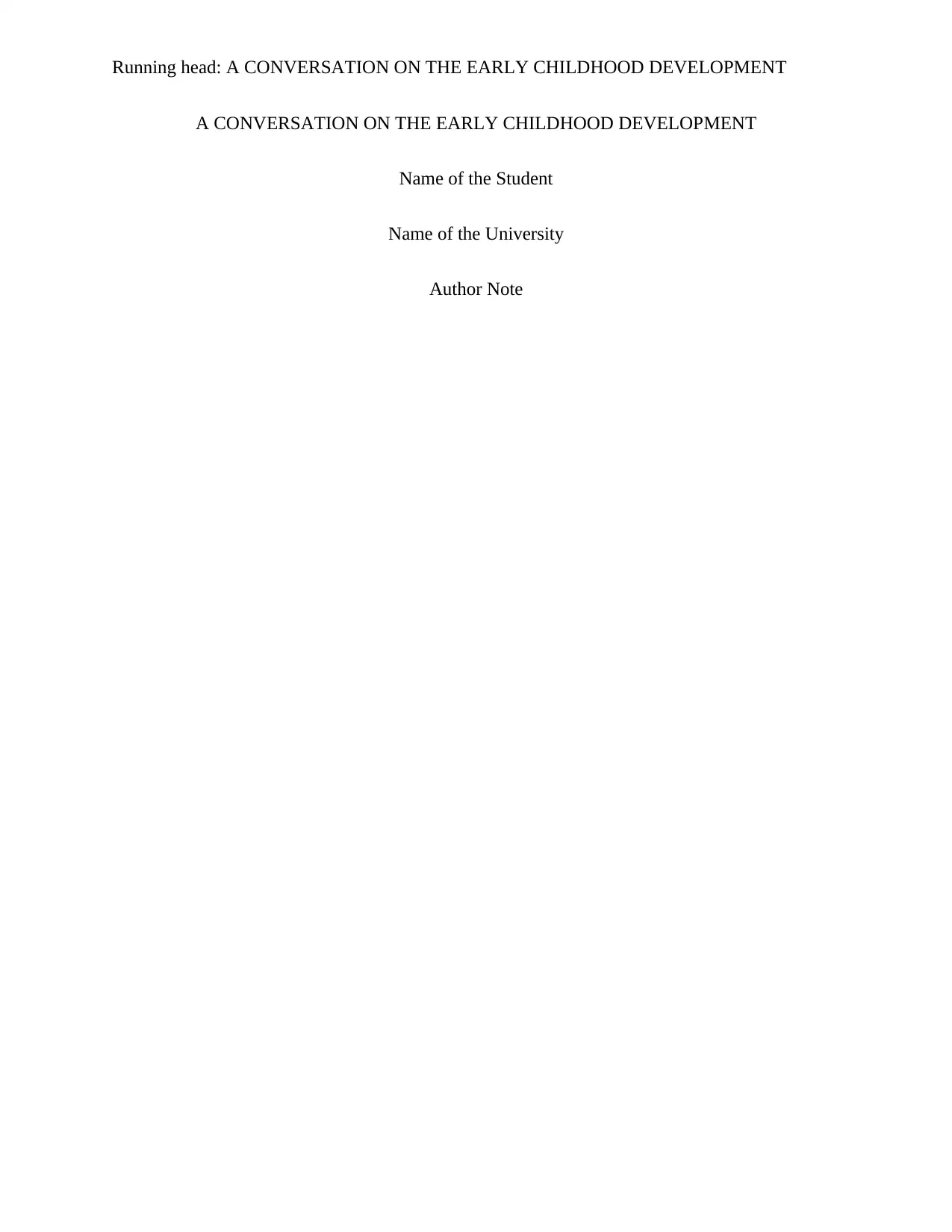
Running head: A CONVERSATION ON THE EARLY CHILDHOOD DEVELOPMENT
A CONVERSATION ON THE EARLY CHILDHOOD DEVELOPMENT
Name of the Student
Name of the University
Author Note
A CONVERSATION ON THE EARLY CHILDHOOD DEVELOPMENT
Name of the Student
Name of the University
Author Note
Paraphrase This Document
Need a fresh take? Get an instant paraphrase of this document with our AI Paraphraser
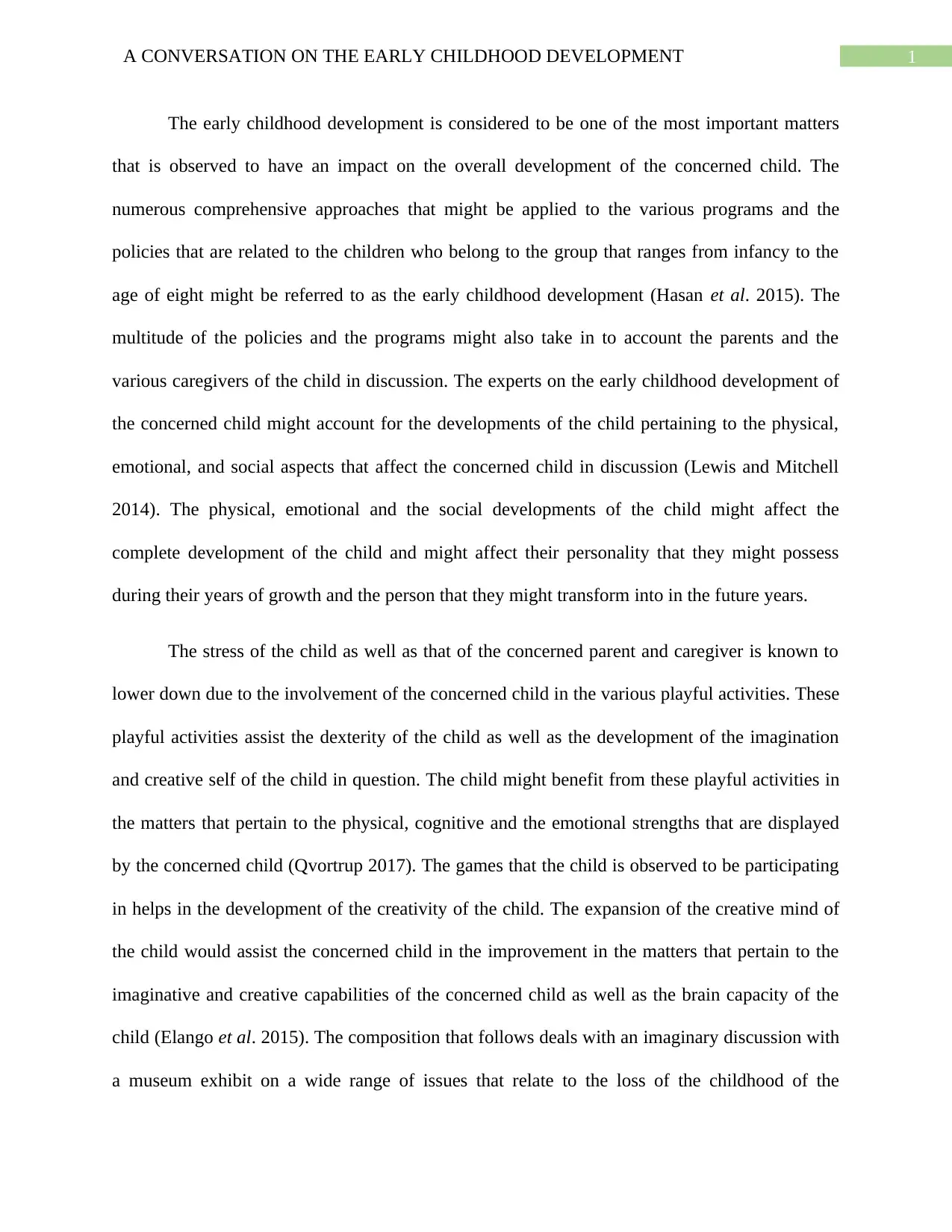
1A CONVERSATION ON THE EARLY CHILDHOOD DEVELOPMENT
The early childhood development is considered to be one of the most important matters
that is observed to have an impact on the overall development of the concerned child. The
numerous comprehensive approaches that might be applied to the various programs and the
policies that are related to the children who belong to the group that ranges from infancy to the
age of eight might be referred to as the early childhood development (Hasan et al. 2015). The
multitude of the policies and the programs might also take in to account the parents and the
various caregivers of the child in discussion. The experts on the early childhood development of
the concerned child might account for the developments of the child pertaining to the physical,
emotional, and social aspects that affect the concerned child in discussion (Lewis and Mitchell
2014). The physical, emotional and the social developments of the child might affect the
complete development of the child and might affect their personality that they might possess
during their years of growth and the person that they might transform into in the future years.
The stress of the child as well as that of the concerned parent and caregiver is known to
lower down due to the involvement of the concerned child in the various playful activities. These
playful activities assist the dexterity of the child as well as the development of the imagination
and creative self of the child in question. The child might benefit from these playful activities in
the matters that pertain to the physical, cognitive and the emotional strengths that are displayed
by the concerned child (Qvortrup 2017). The games that the child is observed to be participating
in helps in the development of the creativity of the child. The expansion of the creative mind of
the child would assist the concerned child in the improvement in the matters that pertain to the
imaginative and creative capabilities of the concerned child as well as the brain capacity of the
child (Elango et al. 2015). The composition that follows deals with an imaginary discussion with
a museum exhibit on a wide range of issues that relate to the loss of the childhood of the
The early childhood development is considered to be one of the most important matters
that is observed to have an impact on the overall development of the concerned child. The
numerous comprehensive approaches that might be applied to the various programs and the
policies that are related to the children who belong to the group that ranges from infancy to the
age of eight might be referred to as the early childhood development (Hasan et al. 2015). The
multitude of the policies and the programs might also take in to account the parents and the
various caregivers of the child in discussion. The experts on the early childhood development of
the concerned child might account for the developments of the child pertaining to the physical,
emotional, and social aspects that affect the concerned child in discussion (Lewis and Mitchell
2014). The physical, emotional and the social developments of the child might affect the
complete development of the child and might affect their personality that they might possess
during their years of growth and the person that they might transform into in the future years.
The stress of the child as well as that of the concerned parent and caregiver is known to
lower down due to the involvement of the concerned child in the various playful activities. These
playful activities assist the dexterity of the child as well as the development of the imagination
and creative self of the child in question. The child might benefit from these playful activities in
the matters that pertain to the physical, cognitive and the emotional strengths that are displayed
by the concerned child (Qvortrup 2017). The games that the child is observed to be participating
in helps in the development of the creativity of the child. The expansion of the creative mind of
the child would assist the concerned child in the improvement in the matters that pertain to the
imaginative and creative capabilities of the concerned child as well as the brain capacity of the
child (Elango et al. 2015). The composition that follows deals with an imaginary discussion with
a museum exhibit on a wide range of issues that relate to the loss of the childhood of the
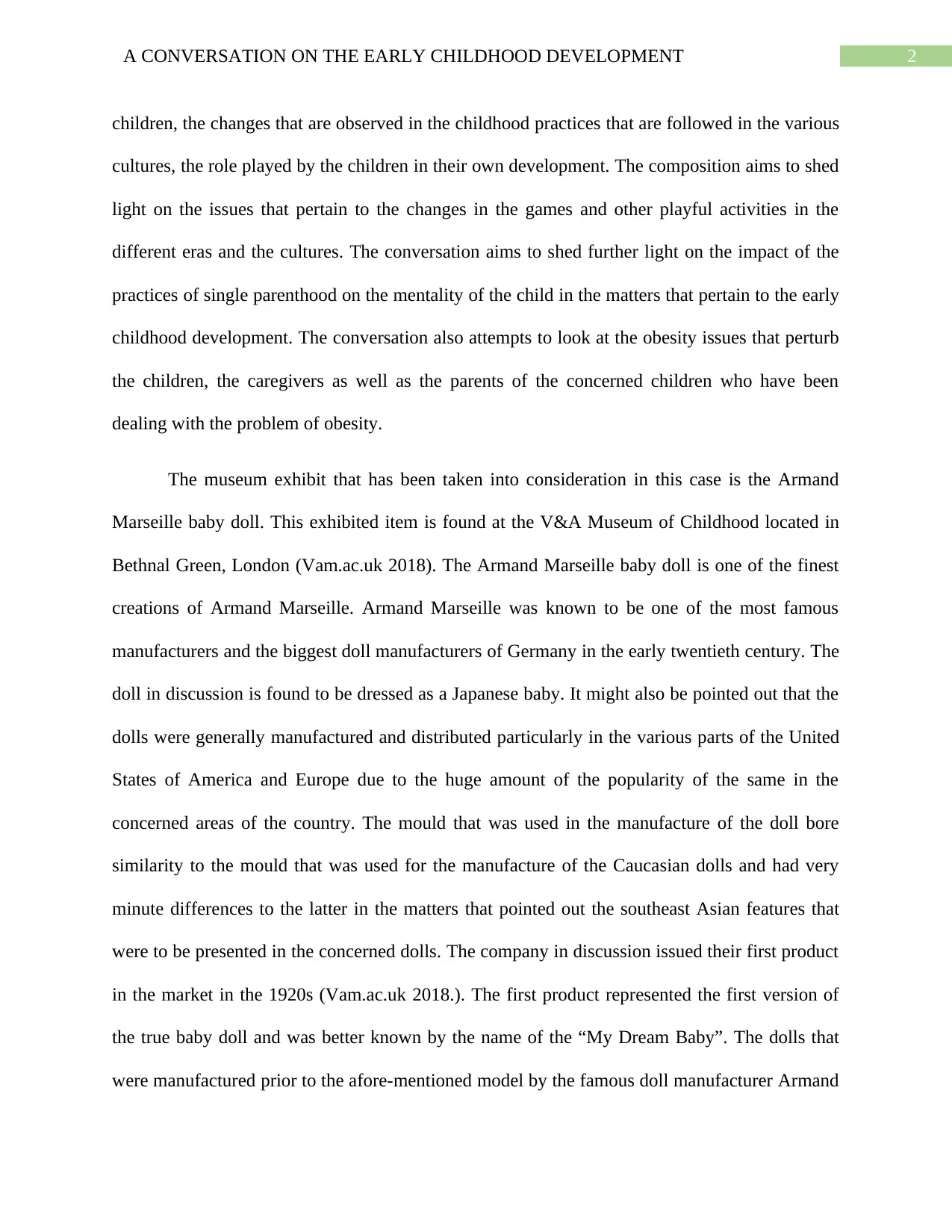
2A CONVERSATION ON THE EARLY CHILDHOOD DEVELOPMENT
children, the changes that are observed in the childhood practices that are followed in the various
cultures, the role played by the children in their own development. The composition aims to shed
light on the issues that pertain to the changes in the games and other playful activities in the
different eras and the cultures. The conversation aims to shed further light on the impact of the
practices of single parenthood on the mentality of the child in the matters that pertain to the early
childhood development. The conversation also attempts to look at the obesity issues that perturb
the children, the caregivers as well as the parents of the concerned children who have been
dealing with the problem of obesity.
The museum exhibit that has been taken into consideration in this case is the Armand
Marseille baby doll. This exhibited item is found at the V&A Museum of Childhood located in
Bethnal Green, London (Vam.ac.uk 2018). The Armand Marseille baby doll is one of the finest
creations of Armand Marseille. Armand Marseille was known to be one of the most famous
manufacturers and the biggest doll manufacturers of Germany in the early twentieth century. The
doll in discussion is found to be dressed as a Japanese baby. It might also be pointed out that the
dolls were generally manufactured and distributed particularly in the various parts of the United
States of America and Europe due to the huge amount of the popularity of the same in the
concerned areas of the country. The mould that was used in the manufacture of the doll bore
similarity to the mould that was used for the manufacture of the Caucasian dolls and had very
minute differences to the latter in the matters that pointed out the southeast Asian features that
were to be presented in the concerned dolls. The company in discussion issued their first product
in the market in the 1920s (Vam.ac.uk 2018.). The first product represented the first version of
the true baby doll and was better known by the name of the “My Dream Baby”. The dolls that
were manufactured prior to the afore-mentioned model by the famous doll manufacturer Armand
children, the changes that are observed in the childhood practices that are followed in the various
cultures, the role played by the children in their own development. The composition aims to shed
light on the issues that pertain to the changes in the games and other playful activities in the
different eras and the cultures. The conversation aims to shed further light on the impact of the
practices of single parenthood on the mentality of the child in the matters that pertain to the early
childhood development. The conversation also attempts to look at the obesity issues that perturb
the children, the caregivers as well as the parents of the concerned children who have been
dealing with the problem of obesity.
The museum exhibit that has been taken into consideration in this case is the Armand
Marseille baby doll. This exhibited item is found at the V&A Museum of Childhood located in
Bethnal Green, London (Vam.ac.uk 2018). The Armand Marseille baby doll is one of the finest
creations of Armand Marseille. Armand Marseille was known to be one of the most famous
manufacturers and the biggest doll manufacturers of Germany in the early twentieth century. The
doll in discussion is found to be dressed as a Japanese baby. It might also be pointed out that the
dolls were generally manufactured and distributed particularly in the various parts of the United
States of America and Europe due to the huge amount of the popularity of the same in the
concerned areas of the country. The mould that was used in the manufacture of the doll bore
similarity to the mould that was used for the manufacture of the Caucasian dolls and had very
minute differences to the latter in the matters that pointed out the southeast Asian features that
were to be presented in the concerned dolls. The company in discussion issued their first product
in the market in the 1920s (Vam.ac.uk 2018.). The first product represented the first version of
the true baby doll and was better known by the name of the “My Dream Baby”. The dolls that
were manufactured prior to the afore-mentioned model by the famous doll manufacturer Armand
⊘ This is a preview!⊘
Do you want full access?
Subscribe today to unlock all pages.

Trusted by 1+ million students worldwide
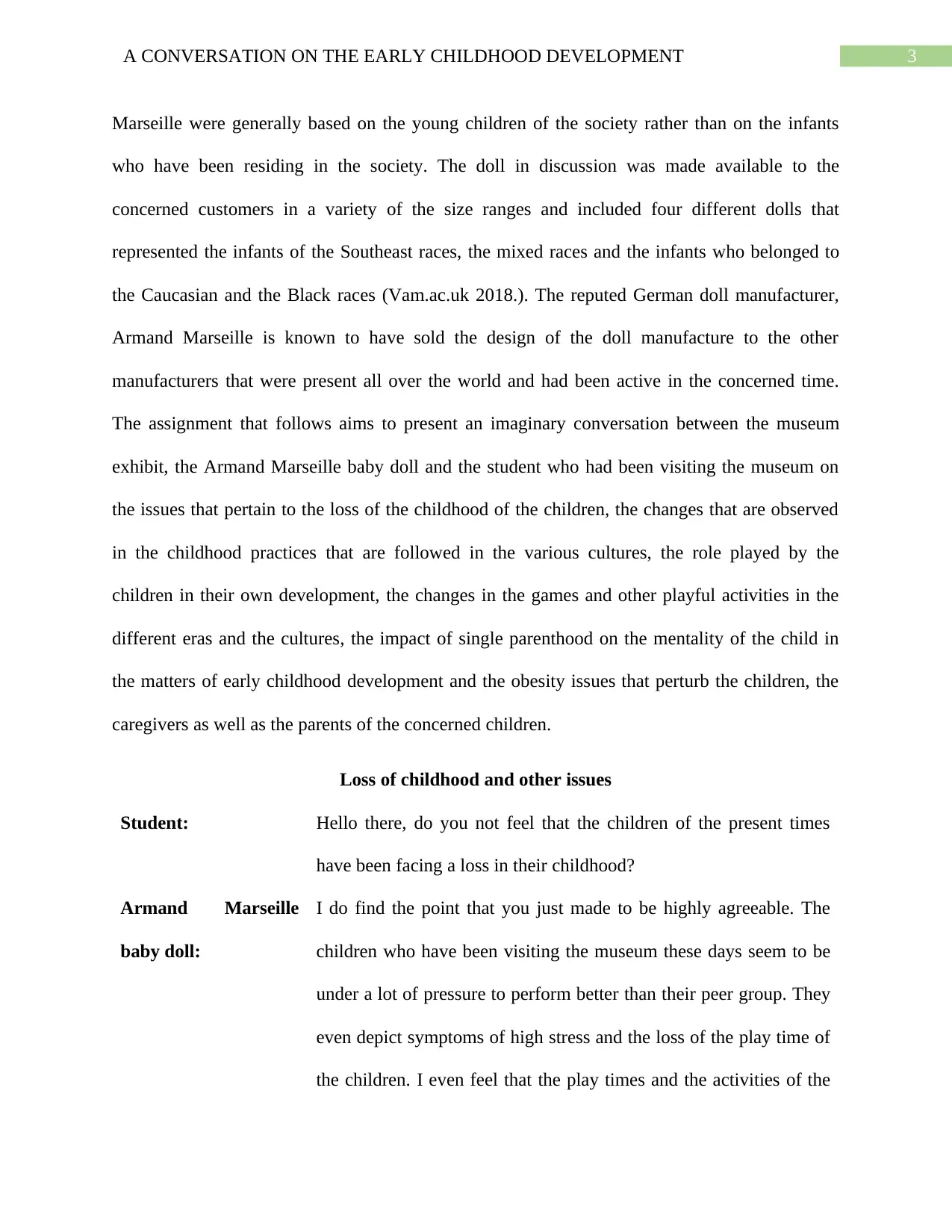
3A CONVERSATION ON THE EARLY CHILDHOOD DEVELOPMENT
Marseille were generally based on the young children of the society rather than on the infants
who have been residing in the society. The doll in discussion was made available to the
concerned customers in a variety of the size ranges and included four different dolls that
represented the infants of the Southeast races, the mixed races and the infants who belonged to
the Caucasian and the Black races (Vam.ac.uk 2018.). The reputed German doll manufacturer,
Armand Marseille is known to have sold the design of the doll manufacture to the other
manufacturers that were present all over the world and had been active in the concerned time.
The assignment that follows aims to present an imaginary conversation between the museum
exhibit, the Armand Marseille baby doll and the student who had been visiting the museum on
the issues that pertain to the loss of the childhood of the children, the changes that are observed
in the childhood practices that are followed in the various cultures, the role played by the
children in their own development, the changes in the games and other playful activities in the
different eras and the cultures, the impact of single parenthood on the mentality of the child in
the matters of early childhood development and the obesity issues that perturb the children, the
caregivers as well as the parents of the concerned children.
Loss of childhood and other issues
Student: Hello there, do you not feel that the children of the present times
have been facing a loss in their childhood?
Armand Marseille
baby doll:
I do find the point that you just made to be highly agreeable. The
children who have been visiting the museum these days seem to be
under a lot of pressure to perform better than their peer group. They
even depict symptoms of high stress and the loss of the play time of
the children. I even feel that the play times and the activities of the
Marseille were generally based on the young children of the society rather than on the infants
who have been residing in the society. The doll in discussion was made available to the
concerned customers in a variety of the size ranges and included four different dolls that
represented the infants of the Southeast races, the mixed races and the infants who belonged to
the Caucasian and the Black races (Vam.ac.uk 2018.). The reputed German doll manufacturer,
Armand Marseille is known to have sold the design of the doll manufacture to the other
manufacturers that were present all over the world and had been active in the concerned time.
The assignment that follows aims to present an imaginary conversation between the museum
exhibit, the Armand Marseille baby doll and the student who had been visiting the museum on
the issues that pertain to the loss of the childhood of the children, the changes that are observed
in the childhood practices that are followed in the various cultures, the role played by the
children in their own development, the changes in the games and other playful activities in the
different eras and the cultures, the impact of single parenthood on the mentality of the child in
the matters of early childhood development and the obesity issues that perturb the children, the
caregivers as well as the parents of the concerned children.
Loss of childhood and other issues
Student: Hello there, do you not feel that the children of the present times
have been facing a loss in their childhood?
Armand Marseille
baby doll:
I do find the point that you just made to be highly agreeable. The
children who have been visiting the museum these days seem to be
under a lot of pressure to perform better than their peer group. They
even depict symptoms of high stress and the loss of the play time of
the children. I even feel that the play times and the activities of the
Paraphrase This Document
Need a fresh take? Get an instant paraphrase of this document with our AI Paraphraser
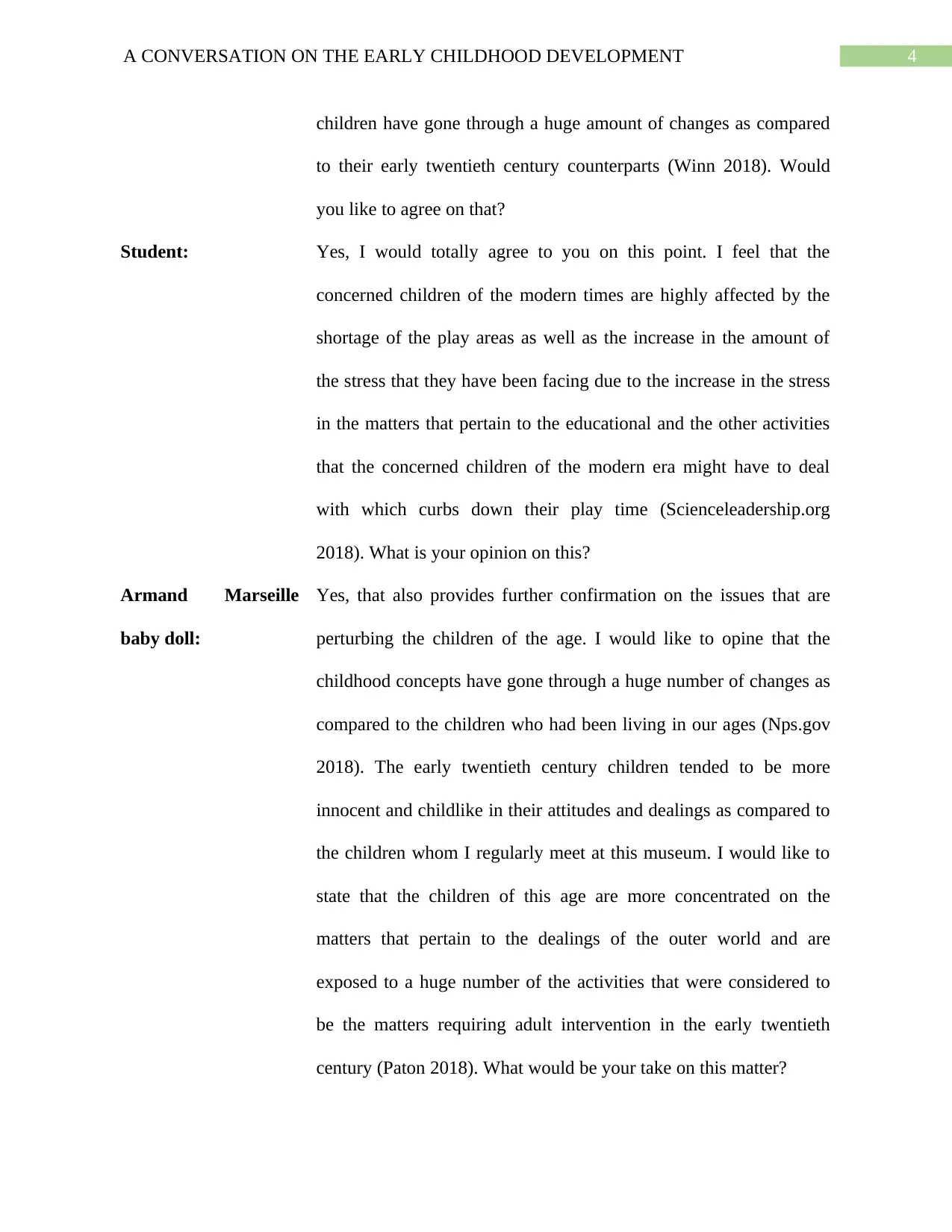
4A CONVERSATION ON THE EARLY CHILDHOOD DEVELOPMENT
children have gone through a huge amount of changes as compared
to their early twentieth century counterparts (Winn 2018). Would
you like to agree on that?
Student: Yes, I would totally agree to you on this point. I feel that the
concerned children of the modern times are highly affected by the
shortage of the play areas as well as the increase in the amount of
the stress that they have been facing due to the increase in the stress
in the matters that pertain to the educational and the other activities
that the concerned children of the modern era might have to deal
with which curbs down their play time (Scienceleadership.org
2018). What is your opinion on this?
Armand Marseille
baby doll:
Yes, that also provides further confirmation on the issues that are
perturbing the children of the age. I would like to opine that the
childhood concepts have gone through a huge number of changes as
compared to the children who had been living in our ages (Nps.gov
2018). The early twentieth century children tended to be more
innocent and childlike in their attitudes and dealings as compared to
the children whom I regularly meet at this museum. I would like to
state that the children of this age are more concentrated on the
matters that pertain to the dealings of the outer world and are
exposed to a huge number of the activities that were considered to
be the matters requiring adult intervention in the early twentieth
century (Paton 2018). What would be your take on this matter?
children have gone through a huge amount of changes as compared
to their early twentieth century counterparts (Winn 2018). Would
you like to agree on that?
Student: Yes, I would totally agree to you on this point. I feel that the
concerned children of the modern times are highly affected by the
shortage of the play areas as well as the increase in the amount of
the stress that they have been facing due to the increase in the stress
in the matters that pertain to the educational and the other activities
that the concerned children of the modern era might have to deal
with which curbs down their play time (Scienceleadership.org
2018). What is your opinion on this?
Armand Marseille
baby doll:
Yes, that also provides further confirmation on the issues that are
perturbing the children of the age. I would like to opine that the
childhood concepts have gone through a huge number of changes as
compared to the children who had been living in our ages (Nps.gov
2018). The early twentieth century children tended to be more
innocent and childlike in their attitudes and dealings as compared to
the children whom I regularly meet at this museum. I would like to
state that the children of this age are more concentrated on the
matters that pertain to the dealings of the outer world and are
exposed to a huge number of the activities that were considered to
be the matters requiring adult intervention in the early twentieth
century (Paton 2018). What would be your take on this matter?
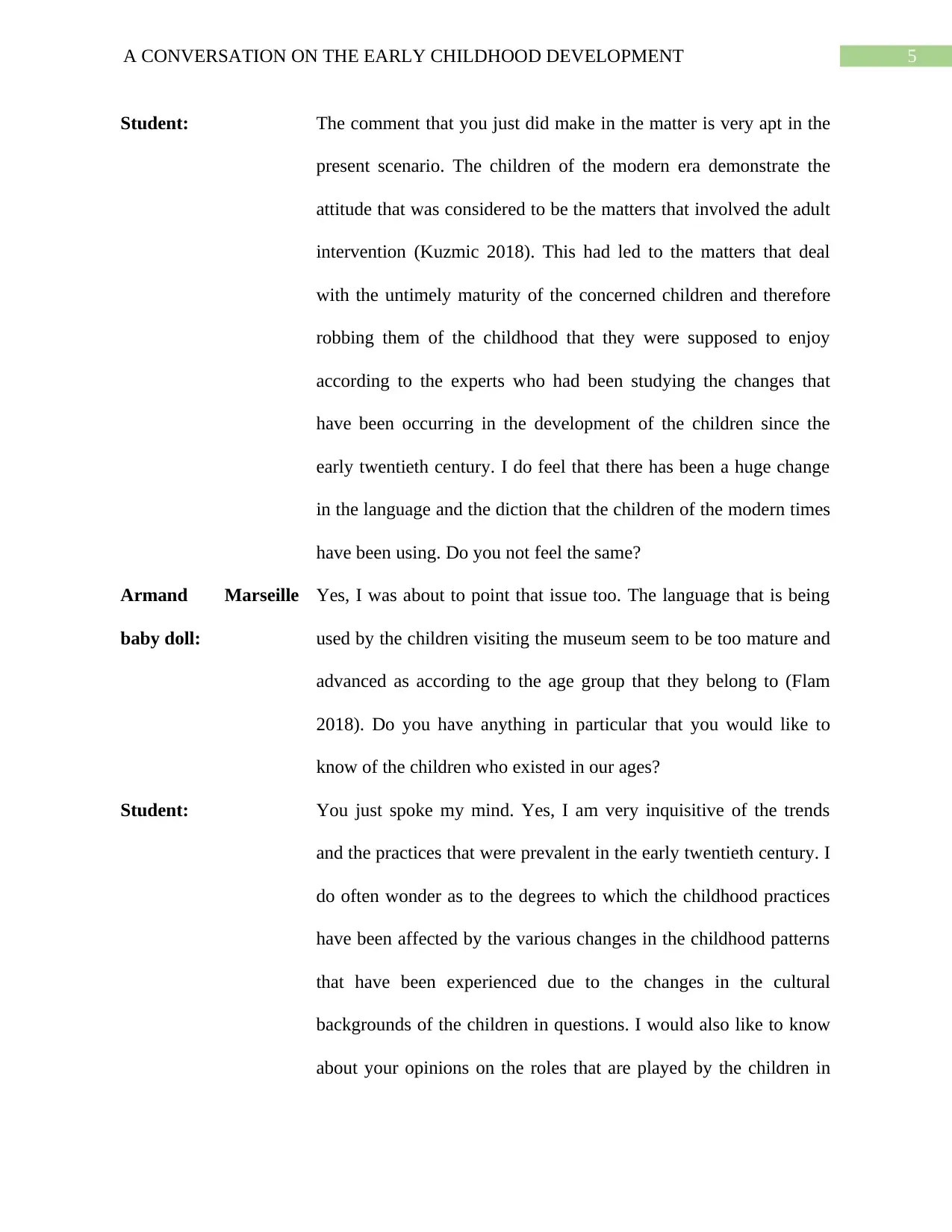
5A CONVERSATION ON THE EARLY CHILDHOOD DEVELOPMENT
Student: The comment that you just did make in the matter is very apt in the
present scenario. The children of the modern era demonstrate the
attitude that was considered to be the matters that involved the adult
intervention (Kuzmic 2018). This had led to the matters that deal
with the untimely maturity of the concerned children and therefore
robbing them of the childhood that they were supposed to enjoy
according to the experts who had been studying the changes that
have been occurring in the development of the children since the
early twentieth century. I do feel that there has been a huge change
in the language and the diction that the children of the modern times
have been using. Do you not feel the same?
Armand Marseille
baby doll:
Yes, I was about to point that issue too. The language that is being
used by the children visiting the museum seem to be too mature and
advanced as according to the age group that they belong to (Flam
2018). Do you have anything in particular that you would like to
know of the children who existed in our ages?
Student: You just spoke my mind. Yes, I am very inquisitive of the trends
and the practices that were prevalent in the early twentieth century. I
do often wonder as to the degrees to which the childhood practices
have been affected by the various changes in the childhood patterns
that have been experienced due to the changes in the cultural
backgrounds of the children in questions. I would also like to know
about your opinions on the roles that are played by the children in
Student: The comment that you just did make in the matter is very apt in the
present scenario. The children of the modern era demonstrate the
attitude that was considered to be the matters that involved the adult
intervention (Kuzmic 2018). This had led to the matters that deal
with the untimely maturity of the concerned children and therefore
robbing them of the childhood that they were supposed to enjoy
according to the experts who had been studying the changes that
have been occurring in the development of the children since the
early twentieth century. I do feel that there has been a huge change
in the language and the diction that the children of the modern times
have been using. Do you not feel the same?
Armand Marseille
baby doll:
Yes, I was about to point that issue too. The language that is being
used by the children visiting the museum seem to be too mature and
advanced as according to the age group that they belong to (Flam
2018). Do you have anything in particular that you would like to
know of the children who existed in our ages?
Student: You just spoke my mind. Yes, I am very inquisitive of the trends
and the practices that were prevalent in the early twentieth century. I
do often wonder as to the degrees to which the childhood practices
have been affected by the various changes in the childhood patterns
that have been experienced due to the changes in the cultural
backgrounds of the children in questions. I would also like to know
about your opinions on the roles that are played by the children in
⊘ This is a preview!⊘
Do you want full access?
Subscribe today to unlock all pages.

Trusted by 1+ million students worldwide

6A CONVERSATION ON THE EARLY CHILDHOOD DEVELOPMENT
the matters that pertain to their own development. I often wonder
whether they do play a positive or a negative role in the matter. The
other matter that seems to get me thinking is the changes that might
be faced by the concerned children in the matters that deal with the
playtime and the play activities of the concerned children. The
impact of the single parenthood and the obesity issues that were
faced by the children of the early twentieth century also tend to get
me thinking on the matter. However, of all the matters, the changes
in the playtime and the play activities of the children tend to get me
thinking the most. Could you please help me quench the
inquisitiveness that I have been facing in the concerned matters?
Armand Marseille
baby doll:
Now that is a long list of questions that seem to be worrying you.
However, I would like to shed some light on the changed in the play
activities and the play timings of the concerned children. I would
like to inform you on the fact that the early twentieth century
children enjoyed their childhood and took part in the various playful
activities and games that are still present in the current scenarios
(Cunningham 2014). I can assure you with the fact that there have
been a multitude of queries that had been arising in your mind while
you had been touring the museum until you finally reached me (de
Zordo and Shanks 2017). Would you please co-operate with me in
solving the queries that have been arising in your mind?
Student: The play and games issues that are faced by the children in this era
the matters that pertain to their own development. I often wonder
whether they do play a positive or a negative role in the matter. The
other matter that seems to get me thinking is the changes that might
be faced by the concerned children in the matters that deal with the
playtime and the play activities of the concerned children. The
impact of the single parenthood and the obesity issues that were
faced by the children of the early twentieth century also tend to get
me thinking on the matter. However, of all the matters, the changes
in the playtime and the play activities of the children tend to get me
thinking the most. Could you please help me quench the
inquisitiveness that I have been facing in the concerned matters?
Armand Marseille
baby doll:
Now that is a long list of questions that seem to be worrying you.
However, I would like to shed some light on the changed in the play
activities and the play timings of the concerned children. I would
like to inform you on the fact that the early twentieth century
children enjoyed their childhood and took part in the various playful
activities and games that are still present in the current scenarios
(Cunningham 2014). I can assure you with the fact that there have
been a multitude of queries that had been arising in your mind while
you had been touring the museum until you finally reached me (de
Zordo and Shanks 2017). Would you please co-operate with me in
solving the queries that have been arising in your mind?
Student: The play and games issues that are faced by the children in this era
Paraphrase This Document
Need a fresh take? Get an instant paraphrase of this document with our AI Paraphraser
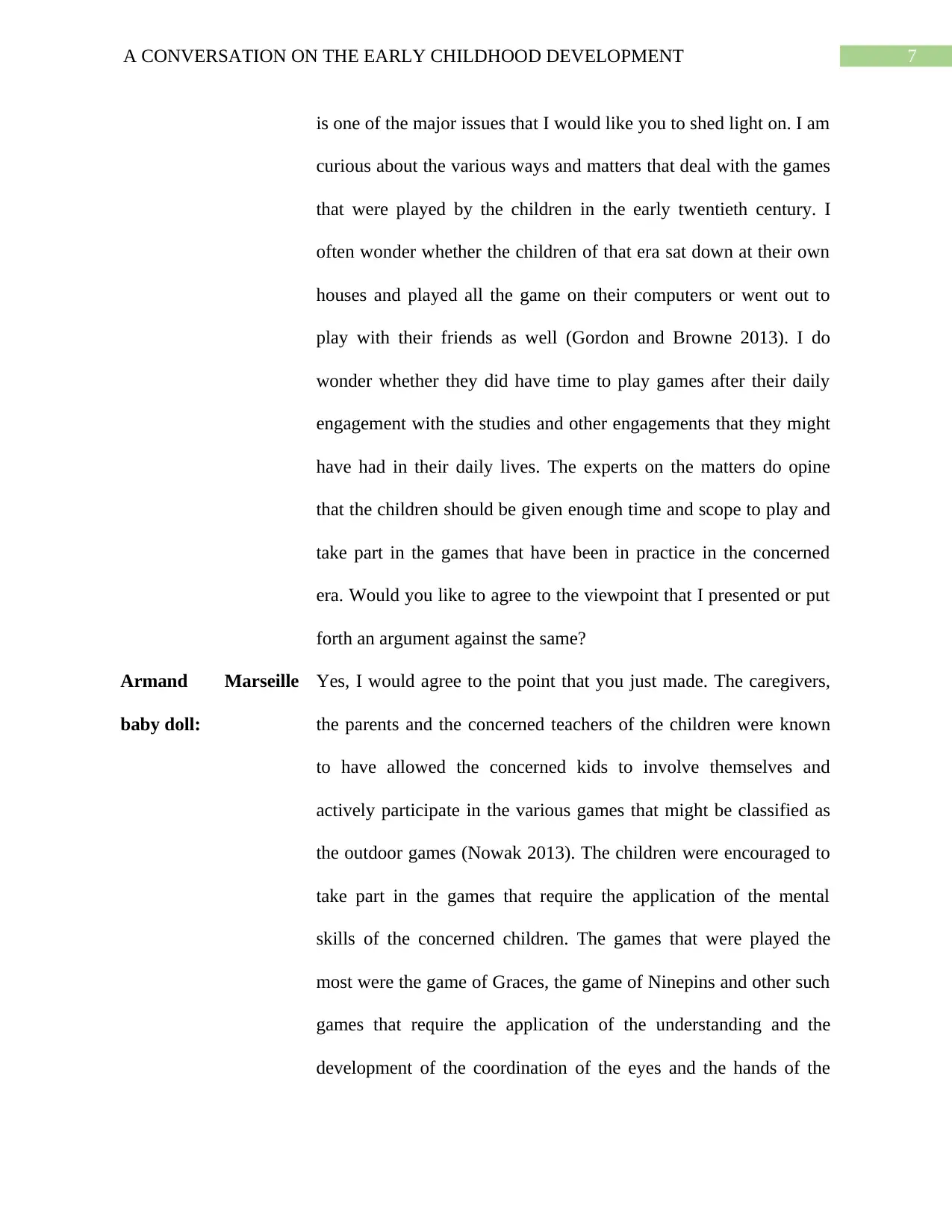
7A CONVERSATION ON THE EARLY CHILDHOOD DEVELOPMENT
is one of the major issues that I would like you to shed light on. I am
curious about the various ways and matters that deal with the games
that were played by the children in the early twentieth century. I
often wonder whether the children of that era sat down at their own
houses and played all the game on their computers or went out to
play with their friends as well (Gordon and Browne 2013). I do
wonder whether they did have time to play games after their daily
engagement with the studies and other engagements that they might
have had in their daily lives. The experts on the matters do opine
that the children should be given enough time and scope to play and
take part in the games that have been in practice in the concerned
era. Would you like to agree to the viewpoint that I presented or put
forth an argument against the same?
Armand Marseille
baby doll:
Yes, I would agree to the point that you just made. The caregivers,
the parents and the concerned teachers of the children were known
to have allowed the concerned kids to involve themselves and
actively participate in the various games that might be classified as
the outdoor games (Nowak 2013). The children were encouraged to
take part in the games that require the application of the mental
skills of the concerned children. The games that were played the
most were the game of Graces, the game of Ninepins and other such
games that require the application of the understanding and the
development of the coordination of the eyes and the hands of the
is one of the major issues that I would like you to shed light on. I am
curious about the various ways and matters that deal with the games
that were played by the children in the early twentieth century. I
often wonder whether the children of that era sat down at their own
houses and played all the game on their computers or went out to
play with their friends as well (Gordon and Browne 2013). I do
wonder whether they did have time to play games after their daily
engagement with the studies and other engagements that they might
have had in their daily lives. The experts on the matters do opine
that the children should be given enough time and scope to play and
take part in the games that have been in practice in the concerned
era. Would you like to agree to the viewpoint that I presented or put
forth an argument against the same?
Armand Marseille
baby doll:
Yes, I would agree to the point that you just made. The caregivers,
the parents and the concerned teachers of the children were known
to have allowed the concerned kids to involve themselves and
actively participate in the various games that might be classified as
the outdoor games (Nowak 2013). The children were encouraged to
take part in the games that require the application of the mental
skills of the concerned children. The games that were played the
most were the game of Graces, the game of Ninepins and other such
games that require the application of the understanding and the
development of the coordination of the eyes and the hands of the
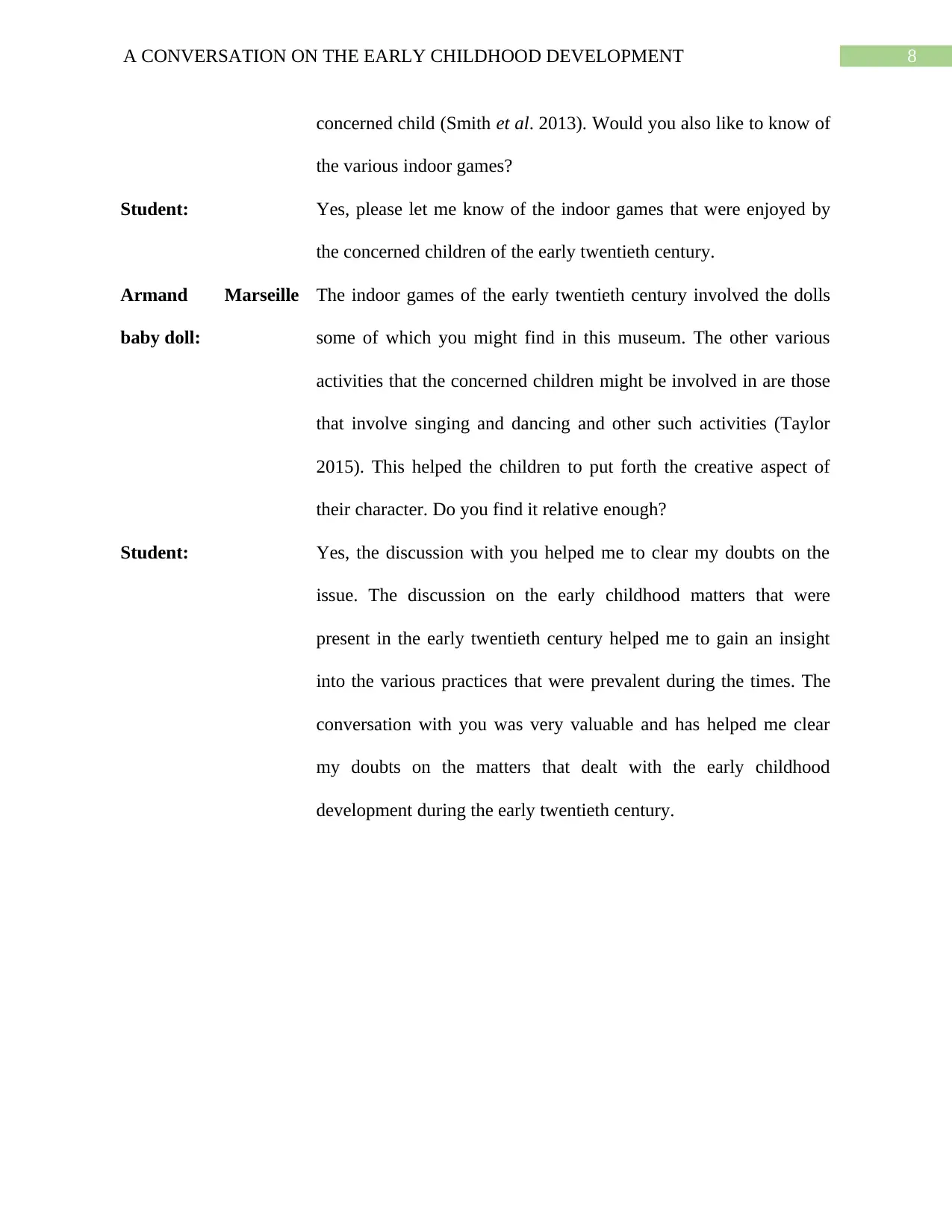
8A CONVERSATION ON THE EARLY CHILDHOOD DEVELOPMENT
concerned child (Smith et al. 2013). Would you also like to know of
the various indoor games?
Student: Yes, please let me know of the indoor games that were enjoyed by
the concerned children of the early twentieth century.
Armand Marseille
baby doll:
The indoor games of the early twentieth century involved the dolls
some of which you might find in this museum. The other various
activities that the concerned children might be involved in are those
that involve singing and dancing and other such activities (Taylor
2015). This helped the children to put forth the creative aspect of
their character. Do you find it relative enough?
Student: Yes, the discussion with you helped me to clear my doubts on the
issue. The discussion on the early childhood matters that were
present in the early twentieth century helped me to gain an insight
into the various practices that were prevalent during the times. The
conversation with you was very valuable and has helped me clear
my doubts on the matters that dealt with the early childhood
development during the early twentieth century.
concerned child (Smith et al. 2013). Would you also like to know of
the various indoor games?
Student: Yes, please let me know of the indoor games that were enjoyed by
the concerned children of the early twentieth century.
Armand Marseille
baby doll:
The indoor games of the early twentieth century involved the dolls
some of which you might find in this museum. The other various
activities that the concerned children might be involved in are those
that involve singing and dancing and other such activities (Taylor
2015). This helped the children to put forth the creative aspect of
their character. Do you find it relative enough?
Student: Yes, the discussion with you helped me to clear my doubts on the
issue. The discussion on the early childhood matters that were
present in the early twentieth century helped me to gain an insight
into the various practices that were prevalent during the times. The
conversation with you was very valuable and has helped me clear
my doubts on the matters that dealt with the early childhood
development during the early twentieth century.
⊘ This is a preview!⊘
Do you want full access?
Subscribe today to unlock all pages.

Trusted by 1+ million students worldwide
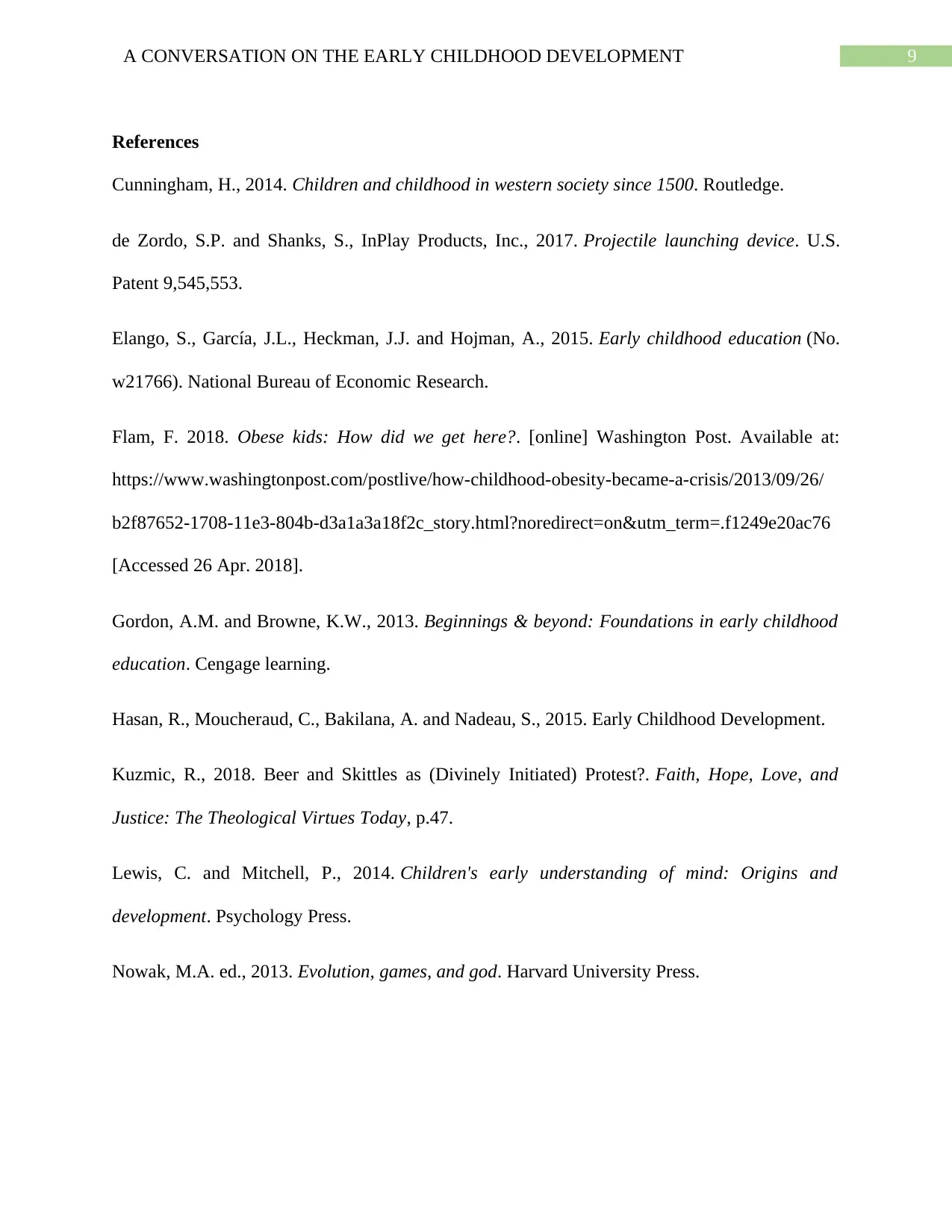
9A CONVERSATION ON THE EARLY CHILDHOOD DEVELOPMENT
References
Cunningham, H., 2014. Children and childhood in western society since 1500. Routledge.
de Zordo, S.P. and Shanks, S., InPlay Products, Inc., 2017. Projectile launching device. U.S.
Patent 9,545,553.
Elango, S., García, J.L., Heckman, J.J. and Hojman, A., 2015. Early childhood education (No.
w21766). National Bureau of Economic Research.
Flam, F. 2018. Obese kids: How did we get here?. [online] Washington Post. Available at:
https://www.washingtonpost.com/postlive/how-childhood-obesity-became-a-crisis/2013/09/26/
b2f87652-1708-11e3-804b-d3a1a3a18f2c_story.html?noredirect=on&utm_term=.f1249e20ac76
[Accessed 26 Apr. 2018].
Gordon, A.M. and Browne, K.W., 2013. Beginnings & beyond: Foundations in early childhood
education. Cengage learning.
Hasan, R., Moucheraud, C., Bakilana, A. and Nadeau, S., 2015. Early Childhood Development.
Kuzmic, R., 2018. Beer and Skittles as (Divinely Initiated) Protest?. Faith, Hope, Love, and
Justice: The Theological Virtues Today, p.47.
Lewis, C. and Mitchell, P., 2014. Children's early understanding of mind: Origins and
development. Psychology Press.
Nowak, M.A. ed., 2013. Evolution, games, and god. Harvard University Press.
References
Cunningham, H., 2014. Children and childhood in western society since 1500. Routledge.
de Zordo, S.P. and Shanks, S., InPlay Products, Inc., 2017. Projectile launching device. U.S.
Patent 9,545,553.
Elango, S., García, J.L., Heckman, J.J. and Hojman, A., 2015. Early childhood education (No.
w21766). National Bureau of Economic Research.
Flam, F. 2018. Obese kids: How did we get here?. [online] Washington Post. Available at:
https://www.washingtonpost.com/postlive/how-childhood-obesity-became-a-crisis/2013/09/26/
b2f87652-1708-11e3-804b-d3a1a3a18f2c_story.html?noredirect=on&utm_term=.f1249e20ac76
[Accessed 26 Apr. 2018].
Gordon, A.M. and Browne, K.W., 2013. Beginnings & beyond: Foundations in early childhood
education. Cengage learning.
Hasan, R., Moucheraud, C., Bakilana, A. and Nadeau, S., 2015. Early Childhood Development.
Kuzmic, R., 2018. Beer and Skittles as (Divinely Initiated) Protest?. Faith, Hope, Love, and
Justice: The Theological Virtues Today, p.47.
Lewis, C. and Mitchell, P., 2014. Children's early understanding of mind: Origins and
development. Psychology Press.
Nowak, M.A. ed., 2013. Evolution, games, and god. Harvard University Press.
Paraphrase This Document
Need a fresh take? Get an instant paraphrase of this document with our AI Paraphraser
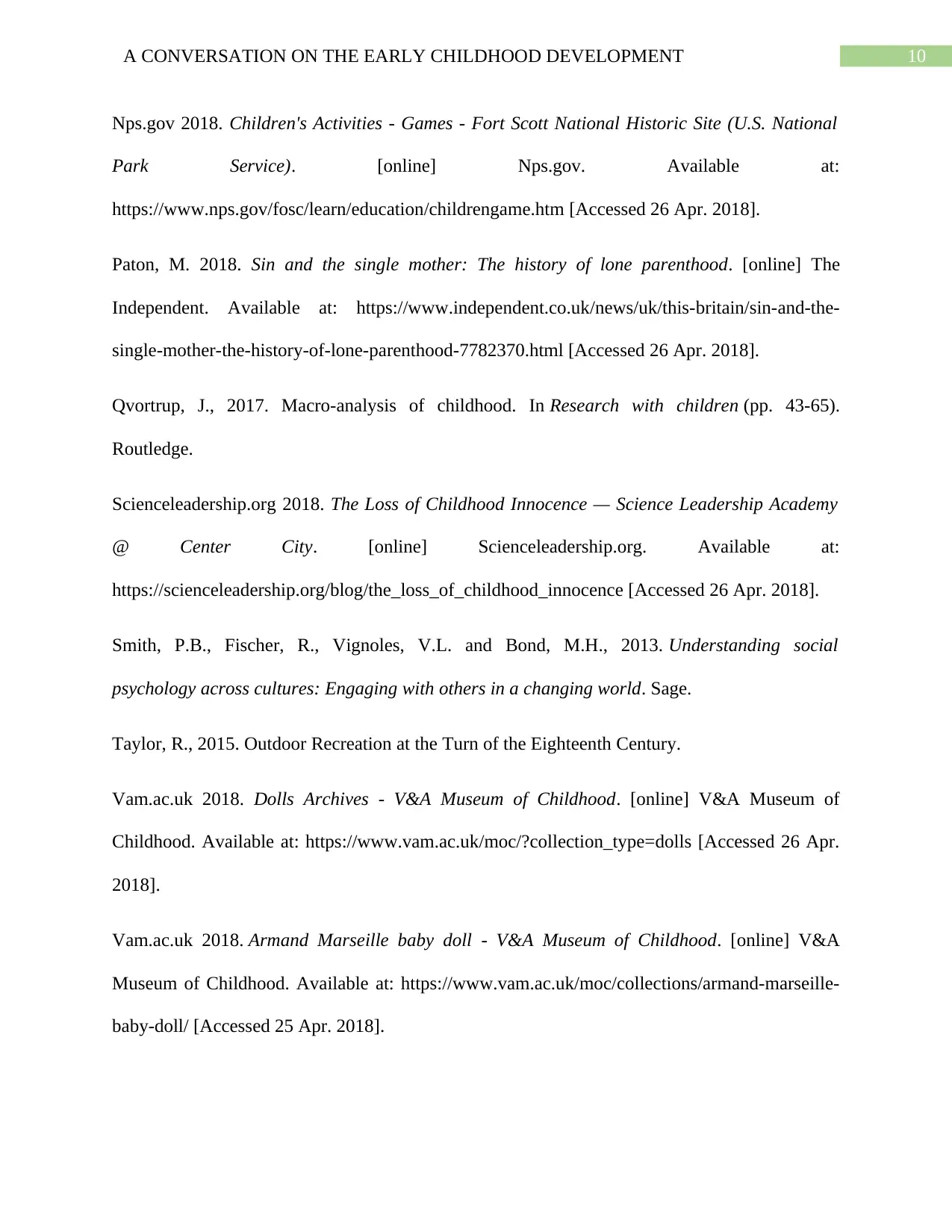
10A CONVERSATION ON THE EARLY CHILDHOOD DEVELOPMENT
Nps.gov 2018. Children's Activities - Games - Fort Scott National Historic Site (U.S. National
Park Service). [online] Nps.gov. Available at:
https://www.nps.gov/fosc/learn/education/childrengame.htm [Accessed 26 Apr. 2018].
Paton, M. 2018. Sin and the single mother: The history of lone parenthood. [online] The
Independent. Available at: https://www.independent.co.uk/news/uk/this-britain/sin-and-the-
single-mother-the-history-of-lone-parenthood-7782370.html [Accessed 26 Apr. 2018].
Qvortrup, J., 2017. Macro-analysis of childhood. In Research with children (pp. 43-65).
Routledge.
Scienceleadership.org 2018. The Loss of Childhood Innocence — Science Leadership Academy
@ Center City. [online] Scienceleadership.org. Available at:
https://scienceleadership.org/blog/the_loss_of_childhood_innocence [Accessed 26 Apr. 2018].
Smith, P.B., Fischer, R., Vignoles, V.L. and Bond, M.H., 2013. Understanding social
psychology across cultures: Engaging with others in a changing world. Sage.
Taylor, R., 2015. Outdoor Recreation at the Turn of the Eighteenth Century.
Vam.ac.uk 2018. Dolls Archives - V&A Museum of Childhood. [online] V&A Museum of
Childhood. Available at: https://www.vam.ac.uk/moc/?collection_type=dolls [Accessed 26 Apr.
2018].
Vam.ac.uk 2018. Armand Marseille baby doll - V&A Museum of Childhood. [online] V&A
Museum of Childhood. Available at: https://www.vam.ac.uk/moc/collections/armand-marseille-
baby-doll/ [Accessed 25 Apr. 2018].
Nps.gov 2018. Children's Activities - Games - Fort Scott National Historic Site (U.S. National
Park Service). [online] Nps.gov. Available at:
https://www.nps.gov/fosc/learn/education/childrengame.htm [Accessed 26 Apr. 2018].
Paton, M. 2018. Sin and the single mother: The history of lone parenthood. [online] The
Independent. Available at: https://www.independent.co.uk/news/uk/this-britain/sin-and-the-
single-mother-the-history-of-lone-parenthood-7782370.html [Accessed 26 Apr. 2018].
Qvortrup, J., 2017. Macro-analysis of childhood. In Research with children (pp. 43-65).
Routledge.
Scienceleadership.org 2018. The Loss of Childhood Innocence — Science Leadership Academy
@ Center City. [online] Scienceleadership.org. Available at:
https://scienceleadership.org/blog/the_loss_of_childhood_innocence [Accessed 26 Apr. 2018].
Smith, P.B., Fischer, R., Vignoles, V.L. and Bond, M.H., 2013. Understanding social
psychology across cultures: Engaging with others in a changing world. Sage.
Taylor, R., 2015. Outdoor Recreation at the Turn of the Eighteenth Century.
Vam.ac.uk 2018. Dolls Archives - V&A Museum of Childhood. [online] V&A Museum of
Childhood. Available at: https://www.vam.ac.uk/moc/?collection_type=dolls [Accessed 26 Apr.
2018].
Vam.ac.uk 2018. Armand Marseille baby doll - V&A Museum of Childhood. [online] V&A
Museum of Childhood. Available at: https://www.vam.ac.uk/moc/collections/armand-marseille-
baby-doll/ [Accessed 25 Apr. 2018].

11A CONVERSATION ON THE EARLY CHILDHOOD DEVELOPMENT
Winn, M. 2018. THE LOSS OF CHILDHOOD. [online] Nytimes.com. Available at:
https://www.nytimes.com/1983/05/08/magazine/the-loss-of-childhood.html [Accessed 26 Apr.
2018].
Winn, M. 2018. THE LOSS OF CHILDHOOD. [online] Nytimes.com. Available at:
https://www.nytimes.com/1983/05/08/magazine/the-loss-of-childhood.html [Accessed 26 Apr.
2018].
⊘ This is a preview!⊘
Do you want full access?
Subscribe today to unlock all pages.

Trusted by 1+ million students worldwide
1 out of 12
Related Documents
Your All-in-One AI-Powered Toolkit for Academic Success.
+13062052269
info@desklib.com
Available 24*7 on WhatsApp / Email
![[object Object]](/_next/static/media/star-bottom.7253800d.svg)
Unlock your academic potential
Copyright © 2020–2025 A2Z Services. All Rights Reserved. Developed and managed by ZUCOL.




